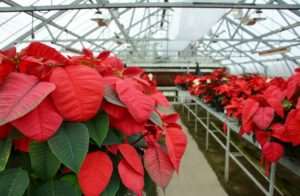By Adam Russell
Rows of vivid red poinsettias inside Greenhouse No. 4 at the Texas A&M AgriLife Research and Extension Center in Overton are as eye-catching as a flashing stop light.
Dr. Brent Pemberton, AgriLife Research ornamental horticulturist in Overton, began a trial of more than 30 varieties of the popular holiday flower associated with Christmas to determine how high temperatures affect the growth and flowering of the tropical perennial.

Poinsettias are grown in the fall for sales around the holidays, Pemberton said. The flower naturally sets its buds as days get shorter.
“Sometimes in Texas we can have warmer temperatures in late September and early October when all of this is happening and those high temperatures can have a deleterious effect on floral development and delay crops,” he said. “Producers need to have poinsettias peaking to within a week of a certain date. Typically stores want them before Black Friday, so they’ll ship them before Thanksgiving.”
For that reason, all commercial poinsettias are grown in greenhouses where producers can control temperatures and conditions to have the flowers peak according to contracts with buyers, Pemberton said.
Over the years, varieties have been developed that can tolerate higher temperatures in Texas and the southern U.S., Pemberton said. Trials have been ongoing for several years and there’s interest within the industry to continue research on poinsettias.
“Those breeding efforts continue, so what we are doing here is testing commercial breeding lines to look at the effects of high temperatures,” he said. “The end product will be more heat-tolerant varieties that are good for Texas growers and consumers.”

Pemberton received the plants in early September. The trial placed varieties in separate greenhouses with daily average temperatures of 72 degrees and 82 degrees.
Poinsettias in higher temperatures during floral initiation tend to stretch and do not develop bracts, which provide the color, as quickly or in preferred numbers, Pemberton said.
Bracts, the recognizable red leafy showcase for the plant, in red varieties, are actually leaves that change physiologically during the natural development of the plant, Pemberton said.
Many plants in the higher temperature greenhouse have yet to flower, he said.
Click here to see more...